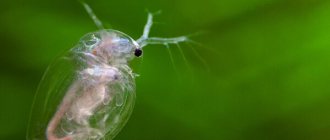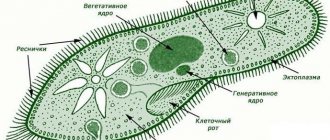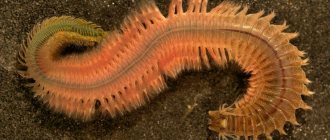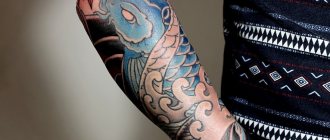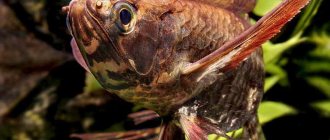- Structure
Life on our planet is distinguished by an incredible diversity of all kinds of living organisms, sometimes having an incredibly complex structure. All this diversity of life: from the simplest insects and plants to us humans (perhaps the most “complex organisms”) consists of cells, these small bricks of living matter. And if man is the crown of biological evolution, then it will be very interesting to consider its beginning: the simplest single-celled organisms, which, in fact, at the dawn of history became the ancestors of all living things. Ciliate slipper (along with
Amoeboia euglena viridae) is one of the most famous simple single-celled creatures. What is the structure of the ciliate slipper, its habitat, how it feeds and reproduces, read about all this further.
Description and characteristics. What does a ciliate slipper look like?
In fact, the ciliate slipper is not at all one simple unicellular organism; behind this name there are more than 7 thousand different types of ciliates. They all share a shape that is somewhat reminiscent of the sole of a shoe, hence the “shoe” in the name. (However, the “slipper” in the name has taken root only here; in English, “slipper ciliate” is listed under the Latin name “Paramecium caudatum”, which translates as “paramecium tailed”).
Also, all ciliates have the ability to osmoregulate, that is, they can regulate
pressure of the internal environment of your body. In this matter, they are helped by two contractile vacuoles; they compress and unclench, thus pushing excess fluid out of the body of the ciliate.
The sizes of the ciliates of the slipper range from 1 to 5 tenths of a millimeter.
Photo of the ciliate slipper.
Although the ciliate slipper is the simplest single-celled creature, that is, its entire body consists of only one cell, nevertheless, it has the ability to independently breathe, feed, reproduce, and move. In other words, it has all the functions and abilities that every other animal has. Moreover, among other simple unicellular organisms, the ciliate slipper is the most complex. In particular among her
There are organelles (cell elements) that are not found in its other unicellular “colleagues”: amoebas and euglena.
Among the “advanced” organelles of ciliates one can note:
Possessing a mouth, powder, and digestive vacuoles, ciliates practice a holozoic type of nutrition, that is, they capture organic particles inside their body.
This is what a ciliate looks like under a shoe
microscope.
Interesting fact: the breathing of the ciliate slipper is carried out not with the help of the mouth, but with the whole body:
Oxygen enters the cytoplasm through the cell covers, where with its help, organic substances are oxidized, converted into carbon dioxide, water and other compounds.
Another amazing feature of ciliates, which makes it “the most complex of the simplest”, is the presence of as many as two nuclei in its cell. One of the nuclei is large, it is called a macronucleus, and the second small one is called a micronucleus. Both cores store the same information, however, if a large core is constantly in operation and its information is constantly exploited, which means it can be damaged (like running books in a library). If such damage occurs, then a second small core is provided just for this case, serving as something of a reserve in case of failure of the main core.
As you can see, our today's heroine, the slipper ciliate, is the most perfect among the simplest single-celled organisms.
Features of life
The slipper ciliate has the property of irritability. This means that she responds to environmental factors (stimulants) by changing her behavior. Irritants are temperature, various substances dissolved in water, lighting. Protozoa do not have a nervous system, sensory organs or reflexes. The entire cell perceives irritation. The reaction to the action of the stimulus will be taxis - this is a movement towards or away from the acting agent.
This can be demonstrated through experiments:
- Place two drops of water on a glass slide - with shoes and clean water and combine them. Then add salt crystals to the water with microorganisms. The shoes will begin to quickly move into clean water, because the high salt content is detrimental to microorganisms.
- And vice versa, if you do not add anything to the water with ciliates, but add an infusion with bacteria to clean water, then the shoes will move towards the bacteria, that is, towards the food.
- If a weak electric current is passed through water containing these microorganisms, they line up along the current line and then move towards the cathode. This phenomenon is called galvanotaxis. It demonstrates the ability of ciliates to respond to stimuli by changing behavior and this is apparently associated with the physicochemical effects of electric current.
Favorable conditions for ciliates are a temperature of about 15-24 degrees Celsius. When it gets colder, the shoes go into suspended animation and turn into cysts. In this state they can exist for years. Under normal conditions, their lifespan is about a day.
Rice. 3. Similarities and differences between Euglena green and Chlamydomanas
Structure
Despite its apparent simplicity, the structure of ciliates is by no means simple. On the outside, it is protected by a thin elastic shell, which also helps the body of the ciliate maintain a constant shape. The protective supporting fibers of the ciliate are located in a layer of dense cytoplasm, which is adjacent to the shell.
In addition, the ciliate cytoskeleton includes various microtubules, alveolar cisterns, basal bodies with cilia, fibrils and filamen and other organelles.
Due to the presence of a cytoskeleton, ciliates, unlike amoeba, cannot arbitrarily change the shape of their body.
Schematic drawing of the structure of ciliates.
Similarities and differences from green euglena
Euglena green is also a unicellular microorganism, that is, the only cell that exists autonomously.
Similarities
- Both microorganisms are unicellular;
- They live in water;
- They are eukaryotes, that is, they have formed nuclei;
- They maintain a constant body shape thanks to a dense cell wall.
Differences
- Ciliates have two nuclei, while euglena has only one.
- The slipper reproduces asexually and sexually, while euglena reproduces only by division.
- The movement of ciliates is ensured by many cilia, and euglena swims with the help of a flagellum.
- The slipper ciliate is colorless, and euglena is green due to the presence of a special pigment - chlorophyll.
- Ciliates feed on organic substances by phagocytosis. Euglena, in addition, can photosynthesize, that is, receive nutrition from carbon dioxide and water in the light with the help of chlorophyll.
- Green euglena has a light-sensitive eye; ciliates do not have such an organ.
Classification
Also, the structure of the ciliate depends on its class. This is how two classes of slipper ciliates are distinguished:
- ciliated ciliates,
- sucking ciliates.
Let's look at them in detail below.
Ciliated ciliates
They are so named because their body is covered with small eyelashes, also called cilia. The length of the eyelash is no more than 0.1 micrometer. Eyelashes can either be distributed evenly over the body of our simplest beauty, or be collected in bunches, which biologists call “cirrhs”. The eyelashes themselves are a bundle of fibrils, which are thread-like proteins.
Each ciliated ciliate can have several thousand of these eyelashes. The movement of ciliates is also carried out using eyelashes.
Sucking ciliates
Sucking ciliates do not have not only cilia, but also a mouth, pharynx and digestive vacuoles, so characteristic of their “hairy” relatives. But they have peculiar tentacles, which are plasma tubes. It is these tentacle-tubes that perform the function of the mouth and pharynx in sucking ciliates, as they capture and conduct nutrients into the endoplasm of the cell.
Without eyelashes, sucking ciliates are unable to move. However, they don’t need this, having a special suction cup leg, they attach to the skin of some crab or fish and live on them. There are only a few dozen species of sucking ciliates, compared to thousands of species of their ciliated counterparts.
Interesting Facts
Slipper ciliates have the ability to distinguish the slightest concentrations of chemicals in water. With this sensitivity, it is easier for them to find colonies of bacteria, that is, food. And in the laboratory, this superpower is sometimes used to determine impurities in water. There was even a tasting of the dried mass of ciliates. It turned out that they taste like chicken or dry cottage cheese. The protein of ciliates contains all the necessary amino acids. Its composition is similar to casein. Clusters of slipper ciliates can be seen with the naked eye, and this is real even at home. Just put a small piece of carrot in a jar of water and place it in a dark, warm place. Water can be taken from a natural reservoir, but tap water will also work. It is best to take water with a small amount of sludge from the aquarium - there are definitely shoes in there. After a couple of days, in the turbidity that surrounds the carrots, it will first be possible to detect ciliates using a microscope. And a little later, when the amount of oxygen in the water decreases, clusters of white dots will appear closer to the surface - these are clusters of ciliates. The slipper ciliate is an amazing representative of single-celled microorganisms. It is structured primitively and at the same time complex. In nature, the slipper ciliate occupies its own ecological niche. It has become an excellent model for studying all the basic processes of life. In addition, these protozoa are used as fish food and as a marker of fluid contamination. You can see what this microorganism looks like and its vital functions in the video.
Previous
Source: sprint-olympic.ru
Habitat
Slipper ciliates usually live in shallow freshwater bodies of water with stagnant water and rotting organic matter. They need standing water so as not to overcome the force of the current, which will carry them away, which is why there are no ciliates in rivers. In shallow reservoirs, the Sun warms the water sufficiently, and rotting organic matter serves as a source of food for them. By the way, by the saturation of a particular reservoir with ciliates, one can judge the degree of its pollution; the more of them, the more polluted the reservoir.
But ciliates do not like salt water, so they are not found in the seas and oceans.
Types of ciliates
It is assumed that there are up to 30 thousand species of ciliates; the calculations use an average value of 8-9 thousand. The ratio among them of parasitic, free-living and commensal is also relative. Approximately 70% of ciliates are considered free-living.
Ciliates parasites
In addition to ordinary ciliates, there are parasitic species that can cause harm to creatures living near them. Among them there are categories that parasitize the body of fish. These harmful single-celled organisms cause diseases that can kill fish. The most common diseases: downy mold, milk disease, Tetrahymena.
Attention! Such parasites live in home aquariums and affect fish with weak immunity.
Ciliates for fry
Aquarists value the shoe for its assistance in the process of growing fish. Single-celled is the smallest food possible, suitable for all types of small fish babies. A real salvation for the owners of capricious fry, who do not feed on anything other than ciliates.
Ciliates parasites
Ciliates - food for fry
Nutrition
What does the slipper ciliate eat? The nutrition of ciliates depends on its class. Thus, sucking ciliates are true predators of the unicellular world: the source of their food is other smaller unicellular organisms, which, to their misfortune, swim by. With their tentacles, sucking ciliates grab other single-celled organisms. Initially, the victim is captured by one tentacle, and then other “brothers” come to the table. The tentacles dissolve the cell membrane of the victim and absorb it inside.
But the ciliated ciliate is “vegetarian” in this regard; its food source is usually unicellular algae, which are captured by the oral recesses, from there they enter the esophagus, and then to the digestive vacuoles. Processed food is thrown out through the powder.
An interesting fact: in the mouth of the ciliated ciliate there are also cilia, which, when swaying, create a current, which carries food particles into the oral area.
Selection
The function of the excretory organs in the slipper ciliate, just like in other protozoa, is performed by contractile vacuoles. The slipper ciliates have two contractile vacuoles - at the anterior and posterior ends of the body. Each contractile vacuole consists of a central reservoir and 5-7 tubules directed towards it. Harmful substances and metabolic products in dissolved form first enter the tubules, and then collect in the central reservoir and are pushed out. The entire cycle of accumulation and removal of metabolic products, as well as excess water, occurs once every approximately 10-20 seconds.
Reproduction
Reproduction of ciliates can be either sexual or asexual - through cell division.
- Sexual reproduction: with it, two ciliates merge with their lateral surfaces, while the membranes between the fused surfaces dissolve, and a kind of cytoplasmic bridge is formed. Through this bridge, cells exchange nuclei. Large nuclei completely dissolve, and small ones divide twice. Then, of the resulting four nuclei, three disappear, and the remaining nucleus is again divided into two. The exchange of remaining nuclei occurs via a cytoplasmic bridge. From the resulting material, newly born nuclei, both large and small, arise. Then the ciliates disperse from each other.
- Asexual reproduction of ciliates through division is much simpler. With it, both cell nuclei are divided into two, like other organelles. Thus, from one ciliate, two are formed, each with a full set of necessary organelles.
Study Opportunities
You can hear the story about the slipper ciliate in school, but not everyone knows how exactly the researchers studied the tiny organism. In fact, there is nothing difficult in observing it, in addition, a size of tenths of a millimeter is quite large for protozoa. All this means that research can be carried out even at home, but first you need to breed a culture of ciliates.
Since slippers are present in all bodies of water, water is taken from these sources. For the purity of the experiment, you need to take three glass containers and put decomposing twigs and leaves in one of them, living plants in the other, and sludge from the bottom in the third. All materials are taken from the reservoir, and liquid is also extracted from there and poured into jars.
When everything is ready, you need to carefully examine the contents of the container and make sure that there are no foreign organisms visible to the eye, such as insects or larvae. If they are present, they will have to be caught, otherwise the ciliates will be eaten. The prepared habitat is placed on a window, covered with glass and left at room temperature for several days. In this case, you need to ensure that the container is not exposed to direct sunlight. After two days, the jar should be shaken and checked to see if any organisms have appeared there. These could be shoes or other creatures, but this is easy to check. You need to take a drop of water from the illuminated wall of the vessel closer to the surface; it is in this place that most of the organisms of interest will concentrate. Then the drop should be placed on glass and examined through a microscope or at least a magnifying glass.
If at the same time fusiform bodies are visible, moving quickly and smoothly and rotating around their axis, it means that the shoes have been separated. If there is a piece of greenery or a bacterial film in the drop, many ciliates will immediately accumulate around the food.
To speed up the reproduction process of ciliates, you need to place them in a favorable environment
It is not difficult to separate the slippers from other animals. They usually move much faster than other organisms, and this is what you need to take advantage of. To do this, a drop, which contains several types of creatures, is placed on glass and placed in a well-lit place. A small amount of fresh water is poured next to it and a toothpick is used to draw a line from one liquid to another so that a thin water bridge is formed connecting the two media. The ciliates will quickly cover the distance and end up in a new drop.
It happens that you cannot see anything living in the water, in which case you can add a few drops of boiled milk to the container and wait another two days. After this time, you can once again try to study the developed organisms.
Next, the shoes will multiply; this process can be accelerated by creating favorable conditions for them. To do this, they are placed in one of the following environments:
- on dried banana peel;
- on lettuce leaves;
- into milk;
- in an infusion of hay.
Organisms bred in this way can be used to observe them for research purposes or bring practical benefits. Since ciliates are natural cleansers of fresh water, they can disinfect liquid in fish aquariums and also serve as food for fry.
Thus, slipper ciliates are amazing organisms with unique characteristics (for example, sexual process without reproduction), they can be studied even at home.
Recommended reading and useful links
- Ehrenberg CG Dritter Beitrag zur Erkenntniss grosser Organization in der Richtung des kleinsten Raumes (German) // Abhandlungen der Koniglichen Akademie der Wissenschaften zu Berlin. Aus dem Jahre 1833: magazine. - Leipzig, 1835. - S. 268-269, 323.
- Ehrenberg CG 502. Paramecium caudatum, geschwanztes Pantoffelthierchen // Die Infusionsthierchen als volkommene Organismen. - Leipzig, 1838. - P. 351-352.
- Polyansky Yu. I. Subkingdom Protozoa, or Single-celled (Protozoa) // Animal Life / ed. Yu. I. Polyansky, ch. ed. V. E. Sokolov. — 2nd ed. - M.: Education, 1987. - T. 1. Protozoa. Coelenterates. Worms. - P. 95-101. — 448 p.
- Warren, A. (2015). Paramecium caudatum Ehrenberg, 1833. In: Warren, A. (2015) World Ciliophora Database. — WoRMS — World Register of Marine Species
How does it move?
The ciliate slipper actively moves with the help of its special cilia, called organelles in science. There are about 15 thousand of them on the surface of one cellular organism. This can be seen under a microscope, looking at a model of a single cell.
Thanks to the clearly organized activity of organelles (they are also called trichocysts), the body rapidly moves like a ship on oars or a pendulum. The movement is fast but smooth.
The organelles quickly rise and then return to their previous position. A lot of such movements happen in one minute. The ciliate moves forward with its blunt tip and turns its body around its axis.
Video
And finally, an educational video on the topic of our article.
Author: Pavel Chaika, editor-in-chief of Poznavaika magazine
When writing the article, I tried to make it as interesting, useful and high-quality as possible. I would be grateful for any feedback and constructive criticism in the form of comments on the article. You can also write your wish/question/suggestion to my email [email protected] or Facebook, with respect, the author.
Author page
This article is available in English -
Paramecium Caudatum – the Most Complex of the Simplest.
What does it eat?
The diet of the slipper ciliate consists of bacteria and microalgae, which are found in large quantities in muddy, stagnant water. Nutrition occurs through the cellular mouth, around which cilia are located. With their help, the microorganism can easily capture as much food as possible into the mouth. From the mouth, food passes through the cellular pharynx, ending up in vacuoles, where the digestion process occurs. It can occur in several vacuoles at once, and can last for more than an hour.
The ciliate slipper can feed continuously, especially when the water temperature is more than 17 degrees, interrupting only for reproduction.



